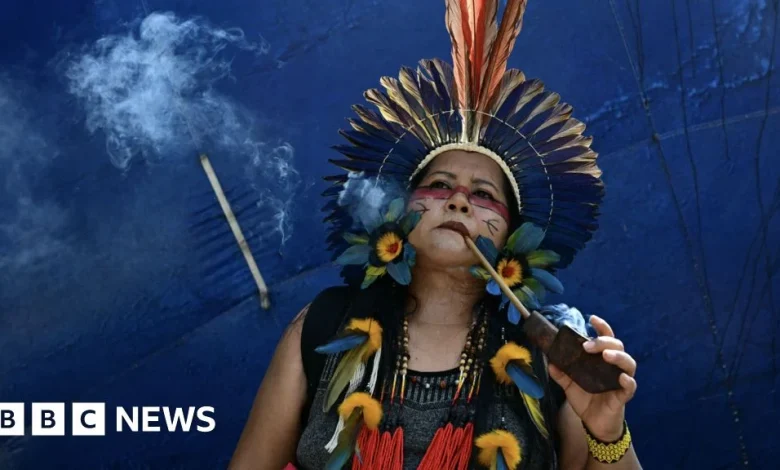Brazil creates new Indigenous territories during protest-hit COP30

COP30 host Brazil has created 10 new Indigenous territories, with the climate summit hit by protests in recent days.
The designation means the areas, including one in part of the Amazon, will have their culture and environment protected under Brazilian law – though this is not always enforced.
The move follows similar actions from President Luiz Inácio Lula da Silva, whose government recognised Indigenous possession of 11 territories last year.
“Each and every indigenous territory in Brazil is a reason to celebrate and is a reason for us to feel happy,” Dinamam Tuxu from the group Articulation of Indigenous Peoples of Brazil (APIB) told the BBC at COP30.
The latest measure will be formalised through a presidential decree.
Mr Tuxu said APIB wants more lands to be recognised legally, giving groups the right to control what happens to the land within the borders.
“Indigenous peoples today protect 82% of the world’s biodiversity. If you demarcate indigenous lands, you guarantee this area will be protected,” he said.
“The traditional way of life of indigenous peoples protects the lands and automatically guarantees global warming will be tackled. Consequently the entire humanity benefits from it,” he added.
Some indigenous groups are attacked when they try to defend their land from cattle ranchers or groups trying to cut down trees for agriculture.
On Sunday an indigenous leader from the Guarani Kaiowá community in the south of Brazil was killed during an attack, according to Survival International.
Vicente Fernandes Vilhalva, 36, was shot in the head when gunmen surrounded the village, according to eyewitnesses who spoke to Survival International.
Thousands protested on Saturday outside the UN’s annual climate conference, with some carrying signs reading “demarcation now”.
And last week, demonstrators – some of whom were from Indigenous groups – carrying signs that read “our forests are not for sale” broke into the summit and tussled with security.
Security around the conference has since increased noticeably, with more armed soldiers and police at the entrance. Lots of Indigenous groups do not have accreditation to go inside.
But this remains the COP with the highest number of representatives from indigenous groups.
“This makes me very happy. We worked for two years and now we have at least 900 people inside the COP where they can negotiate and represent their communities,” Kleber Karipuna, from APIB, told BBC News.
More than 200 human rights groups wrote to UN officials on Monday criticising the enhanced security, saying it “contributes to an increasing global trend towards the silencing of dissent, militarised response to protest, and marginalisation of those defending land and the environment”.
Past recognition of Indigenous reserves banned mining and logging, as well as restricting commercial farming, in the areas they covered to prevent deforestation.
Expanding the total area considered Indigenous territory could prevent up to 20% of additional deforestation and reduce carbon emissions by 26% by 2030, according to a study by the Articulation of Indigenous Peoples of Brazil, the Amazon Environmental Research Institute and the Indigenous Climate Change Committee.
The new protected areas span hundreds of thousands of hectares and are inhabited by thousands of people from the Mura, Tupinambá de Olivença, Pataxó, Guarani-Kaiowá, Munduruku, Pankará, and Guarani-Mbya indigenous peoples.
One area overlaps more than 78% with the Amazon National Park, part of the bio-diverse rainforest which plays a crucial role in regulating the global climate and storing carbon.
The Brazilian government’s announcement came on Indigenous Peoples’ Day at COP30 on Monday.
Until the left-wing Lula re-entered office, no new Indigenous lands had been declared since 2018, it said.
Under his far-right predecessor, Jair Bolsonaro, who promoted mining on Indigenous lands, the protections afforded to them were frequently not enforced.
Lula’s government has previously taken action to drive out illegal miners from indigenous lands.
Currently, Indigenous lands encompass 117.4 million hectares – roughly equivalent to the size of Colombia, or around 13.8% of Brazil’s territory.
Hundreds of Indigenous groups live in Brazil, according to the country’s census.
The Amazon rainforest is already at risk of a renewed surge in deforestation as efforts grow to overturn a key ban to protect it. Thick and healthy forestry helps pull carbon out of the atmosphere.
Carbon released through the burning of fossil fuels has contributed to climate change.
Countries are gathering at COP30 in an effort to reach agreements on how to try to limit global average temperature rises to 1.5C above pre-industrial levels and keep them “well below” 2C.
The UN’s Intergovernmental Panel on Climate Change says a large body of scientific evidence shows that warming of 2C or more would bring serious consequences, including extreme heat, higher sea levels and threats to food security.





